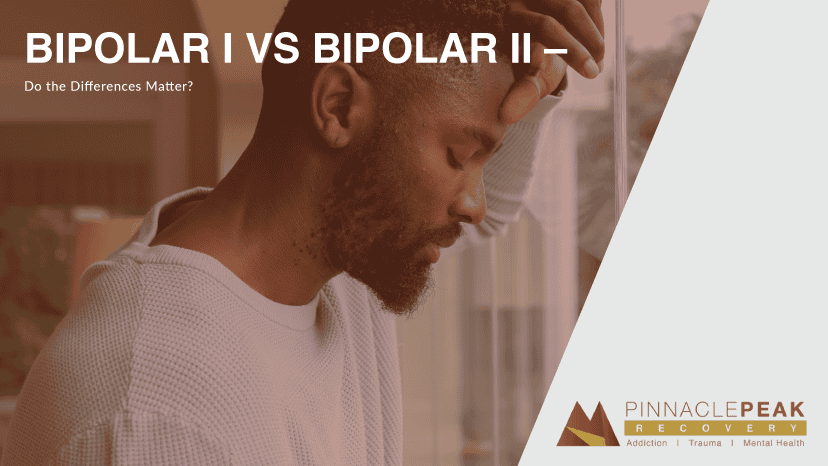Nearly 1 in 3 adults in Arizona who want support for their mental health do not receive the care they need. In fact, Arizona, ranked as the 49th worst state when it came to the ratio of people who needed mental health care versus the amount of care options available.
One of the ways we can help with this is simply through education. – from providing a greater understanding of mental health conditions to reducing the stigma surrounding inpatient mental health care. Our team here at Pinnacle Peak Recovery wants to see our community thrive by making sure more people get access to the care they need and deserve. That’s why we wanted to answer some of the most common questions we hear about specific mental health conditions. We hope this understanding can assist even one person in getting support for their mental health.
Today we’re going to talk about bipolar disorder and compare bipolar I vs. bipolar II. How different are they? Does one diagnosis need more support than another? Let’s talk about it.
How Many Different Types of Bipolar Disorder Are There?
Bipolar disorder, previously known as manic-depressive disorder, is a mental health condition that's defined by episodes of extreme highs or lows. Unlike other mental health conditions such as generalized anxiety disorder or major depressive disorder, bipolar disorder is not a singular diagnosis. Those who are diagnosed with bipolar disorder are put into one of four categories: Bipolar I, Bipolar II, Cyclothymic, or unspecified.
Each of these types of bipolar disorder has overlapping symptoms and a similar disruption to a person’s day-to-day life. The specific type of bipolar they have, however, depends on what kind of symptoms they have, how severe the symptoms are, and how long the symptoms last.
Unspecified bipolar disorder, sometimes known as other specified bipolar, occurs when someone doesn’t meet the criteria for the other three types of bipolar but still has periods of clinically significant and abnormal mood elevation.
So what are the specifications for the other three kinds of bipolar disorder?
Understanding Bipolar I Disorder
Those who have bipolar I will experience manic episodes, or the “extreme highs,” that last at least 7 days at a time or are severe enough to warrant hospitalization.
Manic episodes involve a person feeling very elevated, which can be positive or negative. Often, during manic episodes, a person thinks they’re indestructible, which can lead to rash decisions like giving away money or making big purchases. They often feel like they need little sleep, speak quickly, and are generally jumpy. During these periods they might be quicker to anger, but they can also be quick to shift back into elation.
In order to be qualified as a manic episode, the symptoms must persist most of the day, nearly every day.
People with bipolar I can also experience depressive episodes or mixed episodes, which are episodes where they experience both depressive and manic symptoms. Not everyone with bipolar I will experience the same timeline or exact symptoms, but manic episodes are required to get a bipolar I diagnosis.
Understanding Bipolar II Disorder
Those who have bipolar II primarily experience depressive episodes, or “extreme lows.” They may also experience manic symptoms but at a lesser severity than bipolar I. These are known as hypomanic episodes.
The depressive episodes experienced by those with bipolar II can last for days or weeks and may lead to hospitalization. Those in depressive episodes often experience changes in their sleep cycles, lack of appetite, increased anxiety, and lack of motivation. People in depressive episodes are at increased risk of self-harm and suicidal ideation.
Understanding Cyclothymic Disorder
The thing that sets cyclothymic bipolar apart from bipolar I and II is the severity of the symptoms. People with cyclothymic disorder, often referred to as cyclothymia, have recurring bouts of hypomanic and depressive symptoms, but they don’t last long enough and aren’t intense enough to qualify as episodes.
This doesn’t mean their severity should be undermined. People with cyclothymia still experience disruption in their lives because of their symptoms.

How Similar and Different Are Bipolar I and Bipolar II?
Since bipolar I and bipolar II both fall under the same overarching condition known as Bipolar Disorder, they do have a lot of similarities. However, they wouldn’t be split into two different subsets if they were completely the same.
First, let’s look at the things they share. People with bipolar I and bipolar II both:
- Experience depressive episodes
- Can need to be hospitalized because of their episodes
- Can experience milder episodes
- Can experience mixed episodes
- May have co-occurring mental health conditions
People with bipolar I or bipolar II aren’t going to be exactly like another person with the same diagnosis. Everyone experiences different symptoms at different times, and not every episode that one person experiences will be the same as the next.
Now let’s talk about their differences
Bipolar I’s unique experiences include:
- Manic episodes that last 7+ days or are intense enough to lead to hospitalization
- Can be found in both men and women
- Utilizes the manic symptoms to determine a diagnosis
Bipolar II’s unique experiences include:
- Hypomanic episodes, which are less severe than manic episodes
- More likely to occur in women, but can also occur in men
- May be diagnosed with another form of depressive disorder before determining if it’s bipolar II
Are There Risk Factors for Specific Types of Bipolar Disorder?
There is still much research that needs to be done to determine the origins of mental health conditions such as bipolar disorder. What is known, however, is that most people who have bipolar disorder won’t start to showcase symptoms until their teenage years and beyond. Some studies point to trauma, as well, as a key factor for developing bipolar disorder.
The general risk factors for developing bipolar disorder apply to any form of bipolar disorder. There aren’t noted risks that lead to someone being more likely to develop one kind of bipolar disorder over the other. However, it is important to note that women who have bipolar disorder are more likely to have bipolar II than bipolar I.
Women, overall, are more likely to experience trauma and PTSD than their male counterparts. Studies have also looked into postpartum mental health and found that women with bipolar disorder are at a higher risk of experiencing postpartum psychosis.
There are also risk factors to consider when it comes to episode triggers. Substance use disorders, especially the use of psychostimulants, may lead to an increased risk of triggering an episode. Trauma, depression, and high stress are also factors that can influence the severity of your episodes.
What Are the Treatment and Management Options for Bipolar Disorder?
Bipolar disorder of any kind can be treated and managed with proper care from medical professionals. With a combination of medication and talk therapy options available, treatment can give you the tools you need to work through episodes and symptoms.
There is no singular approach to treatment that works for everyone, which is why there are so many options available. As you go into treatment, make sure you’re open and honest with your medical team who’s helping you. By working together, you can find the right fit for your needs.
When looking into treatment it’s also important to consider your needs as a whole. Do you just need support for your bipolar disorder, or do you have other concerns, too? When someone has two or more conditions that exist at the same time within them, this is known as a co-occurring disorder.
Co-occurring disorders in those with bipolar are more common than you may think. This includes things like PTSD and anxiety, to any form of substance use. Studies show that nearly 50% of people who have bipolar disorder have a substance use disorder at some point in their lives. When looking into treatment, you want to find a place that can help you address not just your bipolar disorder, but treat your person as a whole.
Some people may decide to start in an inpatient facility, to have a safe and neutral place to begin their healing. Others may start with outpatient treatment and stick with that for the duration of their treatment. There’s no wrong way to approach treatment, nor is there a wrong timeline. There are many ongoing support options available for you whenever you need it.

Is There Treatment for Bipolar Disorder Near Me in Arizona?
If you’re looking to get started with bipolar treatment, you’re in the right place. Whether you need help just with your bipolar disorder, or you have other mental health conditions or substance use concerns, there are treatment programs that will work for you.
You don’t have to look far, either. There are facilities here in Arizona that offer inpatient and outpatient treatment for bipolar disorder, with ongoing alumni support, too. No matter your history with bipolar disorder, or your history with treatment, there are places that want to help and will tailor a treatment plan to suit your specific needs.
There’s no wrong time to get started, so why not get started today? Our team here at Pinnacle Peak Recovery is dedicated to providing a compassionate and family feel to your recovery. We offer a wide variety of evidence-based approaches so you can find the right fit for your healing. Give us a call at 866-377-4761 and we’ll be happy to answer any questions you may have.
Clinical Excellence | Compassionate Care | Family Feel

